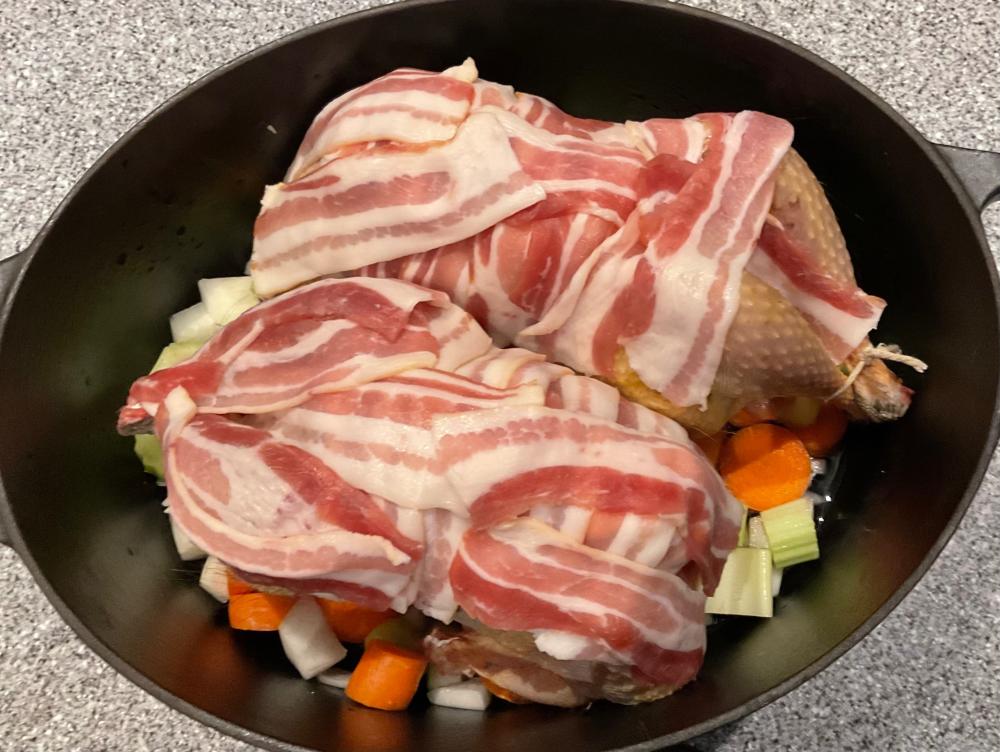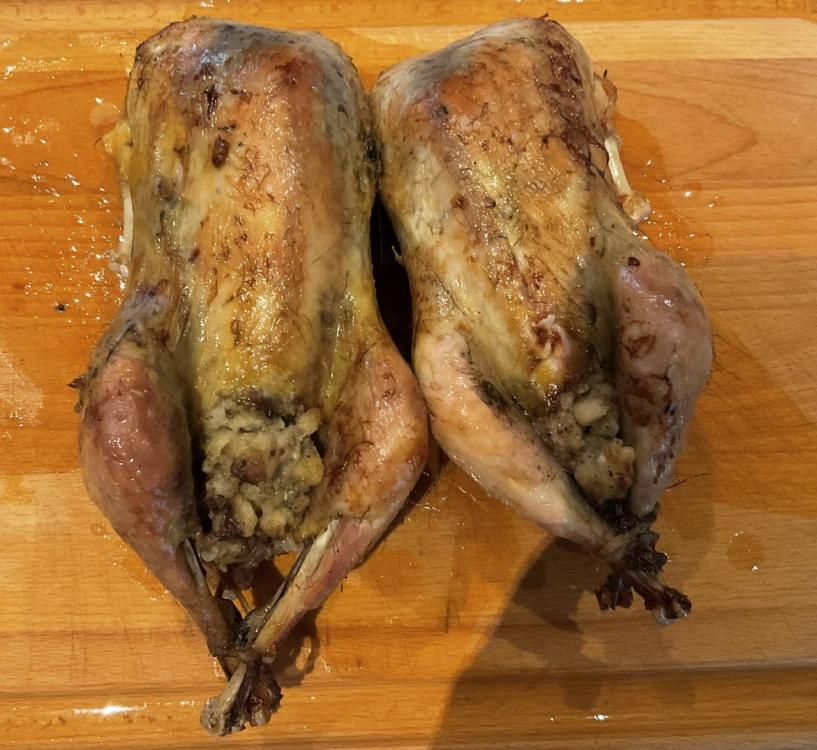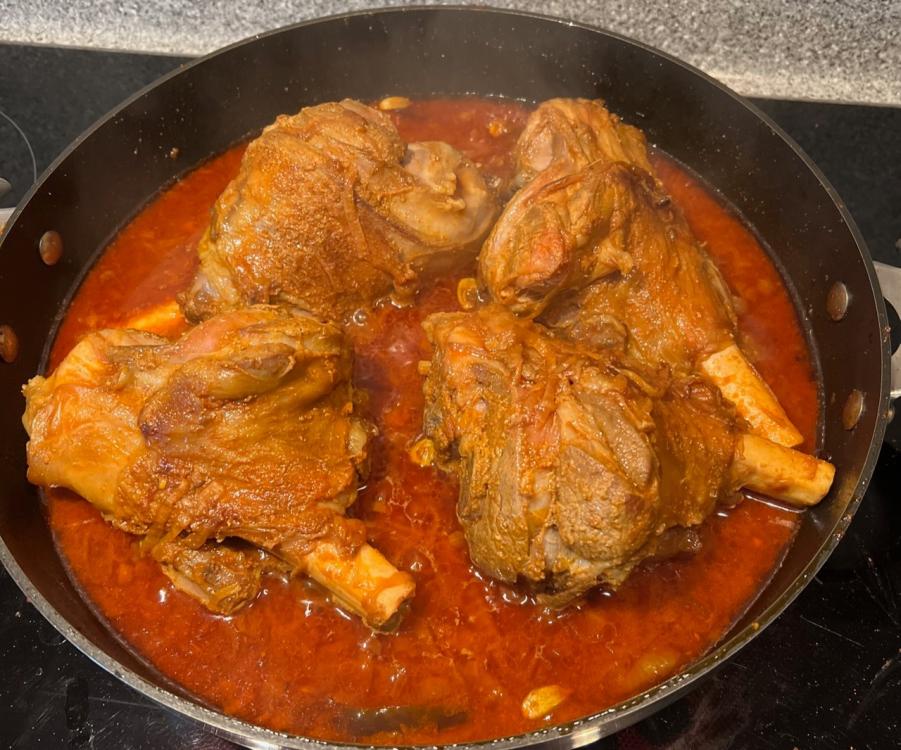-
Posts
205 -
Joined
-
Last visited
Content Type
Profiles
Forums
Store
Help Articles
Everything posted by Tempest63
-
Does Turkish food fall under the Europe umbrella or do we slot it into the Middle East?
-
It comes off the birds for the last 15 minutes, goes on a plate at the bottom of the oven and is then served with the rest of the meal.
-
The older the birds, the tougher they get, the longer they need cooking. I have tried roasting older birds, I have spatchcocked them and cooked them on the stove, but they are better in a casserole when shot during the second half of the season. In the U.K. that is 1st October to 1st February.
-
I do find it really strange that people in the U.K. will comment on how dry their roasted pheasant is and you look at their post which is late season. The roasting window is quite short so towards the end of mid season, I.e., mid to late November, think casserole, curry and stew and forget roasting.
-
-
I roughly followed this recipe https://www.deliaonline.com/recipes/type-of-dish/sunday-roast/roast-pheasant-with-chestnut-stuffing-and-port-and-chestnut-sauce and was really happen with the results. Birds were young season, good for roasting so still very moist. Will definitely do this again.
-
Thanks for that, I’ve had a few of their recipes in the past which have turned out well, this time I want to pot roast so I am going to cook them in a cast iron Dutch oven on top of a bed of veg. I’ve just finished prepping and stuffing them and once they are slathered in butter and have some bacon over the breasts are going in the oven. My daughter cropped some squashes from our allotment this morning so I think roast potatoes, roast squash, something green and a port sauce.
-
I shot on a 20 gun Pheasant Shoot yesterday, whilst the wife worked two of our English Springer Spaniels. Total bag was 93 birds, of which I dropped a few brace round to friends and neighbours. We kept back a couple of young hens which I will prep and roast today, not overly keen on hung game, fresher the better in my book. I’m looking at a (Saint) Delia Smith recipe for today but would be interested in any tried and tested recipes you guys and gals have for young roast pheasant.
-
There have been numerous articles like this in the British press over the years and others that covered changes in immigration rules halting the flow of chefs from Bangladesh. All spelling the end of the BIR (British Indian Restaurant). In realty the BIR trade has changed significantly over the the last 40 years. The food on offer at take always differs greatly from what I was eating back then, menus have grown from the few standard curries ranging from mild to blistering hot, to no end of regional style dishes that no kitchen could expect to turn out tasting close to the original dish. Back then there were only a few “up market” restaurants; Veeraswarmy’s was one of those, based in the West End of London and opening in 1926 it was one of the first, another would be the Bombay Brasserie which opened in 1982. These offered a higher standard of food with individually and well spiced dishes. There are now many such establishments, cream of the crop in my opinion are the Cinnamon Club/Cinnamon Kitchen range and between them comes the likes of Dishoom. As well as that, with the number of good authors out there offering traditional recipes, and the ready availability of the necessary ingredients, people are prepared to invest their time in preparing a good home cooked curry that stands head and shoulders, taste wise, above what the BIR are offering. The demise of the BIR must be weighed against its former popularity. Every small town could have a number of curry houses, but the trend has peaked and a number can no longer operate in the dwindling market so whereas you may have had the choice of several in a town, now you may only have two. And the latest blow is the cost of living crisis which has pushed down both the quality and quantity of food. I rarely eat from a BIR these days, but have had reason to turn to a take away curry in recent weeks. My post to another website earlier this month, which I have copied below, outlines why I won’t be rushing back. The BBC is running a story on the current cost of a takeaway curry in various regions of the U.K. Indian takeaways: Restaurant owners say high prices down to perfect storm https://www.bbc.co.uk/news/newsbeat-67138765 The wife and I used to have a takeaway most weeks but in our area, a medium sized town midway between Chelmsford and Colchester, the cost is becoming prohibitive. A main course each, a couple of chapatis, two veg side dishes and some poppadoms (which used to be free) is now close to £45. The price seems to be a bit of a lottery; we add up the cost of the order and even though we have the latest menu, an additional 3 or 4 quid is always added to the order. I don’t know if this is now for delivery, despite the menu stating delivery is free but it means the delivery guys and gals don’t get as big a tip as they used to receive from us. The takeaway opens at 17.00 but has recently decided to deliver from 18.00 hours, meaning the food is invariably tepid and can arrive too late to eat before bed. The biggest problem is the quality of the food. I tend to order from the tandoori section, mixed grill or chicken shaslik, whilst the wife focuses on some of the “regional specialities”, shaktora or Nawabi. I’ve noticed on a chicken shaslik that the quantity of chicken has reduced to be replaced with added onion or tomato, whilst the wife says everything off the regional menu tastes exactly the same, there is no variation in the sauces. This is from the take away that we have used for many years, it has never been the greatest but was the best of the lot. A rival opened a few years back claiming to offer a “fine dining takeaway experience”, a claim they never substantiated but it was a better take away and carried a premium price. We used it for a short while but reverted to our usual take away after a while. I’m told now that this high end restaurant has also increased its cost but has nearly halved its portion size and quality has fallen away. The owner of a local Tapas bar used to sing the praises of this high end option but was so disappointed with recent meals he told the restaurateur, a friend, that he could no longer recommend the place anymore and would no longer being ordering from there, and these guys are/were good buddies. We all know the Indian restaurant trade has been in trouble for years now, I just wonder if this is the death knell for the industry from which it won’t claw itself back?
-

British cooking/Britain's food history and reputation
Tempest63 replied to a topic in Food Traditions & Culture
The point I was trying to make, in a slightly humorous way (apologies if if didn’t come across that way), is that the advent of convenience food and large frozen food stores meant a quick alternative to proper cooking. Busy mums, and some that were not so busy, found that instead of cooking a traditional meal they had something frozen, pre prepared, that they could slam in the oven and feed the kids. The Findus products I mentioned were an example of such food, high in fats and salt, that were inflicted upon a generation. Having been raised on real food, these convenient alternatives never sat well with me. I absolutely refused to put this type of food in front of my kids when they were growing up and as such my weekends were spent batch cooking good fresh ingredients for my busy wife to serve to the kids as an evening meal. I enjoyed cooking back then as I do now, so it was no chore to sit down with four young kids on a Saturday morning and let them help put the weekly menu together which I would then prepare for them to eat during the week. That has now carried over to the next generation and my grandchildren now help choose what to eat during the week. -
Good article on Pie and Mash. We Londoners do love our pie and mash and as I pointed out my comment was tongue in cheek. I agree that the pie shops are dying out, and of those that remain, the cost of pie and mash has sky rocketed over the last few years. The population of London has altered dramatically with the influx of immigrants and a lot of those would not be drawn to our local dish. However where Londoners go pie and mash follows; two shops have opened in Chelmsford recently and a further Manzes (no relation to the original family surprisingly) has opened in the small town of Braintree. Polly’s is the latest to have opened in Witham since lockdown, so whilst the number of shops have diminished in London, they are starting to thrive elsewhere.
-
The market is close to where I was born and where my mother lived until she fled this mortal coil a year ago. I used to use it a lot for fresh and varied foods; you could often rely on finding something unusual to grace a dinner table for friends. Unfortunately most of the artisan food producers have left now and what is left is a large number of overpriced street food vendors out to capture tourists with poor quality, mass produced food. Last time I went was for fresh porcini/ceps for a soup, but quickly realised I would need a second mortgage to buy a kilo or so. I ended up using supermarket mushrooms with some dried porcini from a very large bag brought back from Italy for a few euros. we do have some great farmers markets springing up in the U.K. now and their produce is very much as good as that formerly found at Borough market, often with a lot less miles between home and point of sale.
-

British cooking/Britain's food history and reputation
Tempest63 replied to a topic in Food Traditions & Culture
Us Brits have always been mocked by our continental cousins for inferior food, but I remember my mum putting a chicken casserole on the table that was as good as any poule au pot served up by a French housewife, a beef stew that tasted better than a Belgian carbonnade, and the best ever cod cutlet in a fresh, home made parsley sauce, no packet stuff then. No, it all went wrong with the arrival of convenience foods in the 1970’s, especially Findus Crispy Pancakes. Arriving home from school to find, no chops, chicken or fish, but instead a plate with a fried cardboard outer filled with something akin to kit-e-kat filling was the biggest culinary disaster in the history of U.K. cuisine. Even the Goblin meat puddings (boil in the tin) were better, as was the Fray Bentos bake in the tin meat pies. Findus and their crispy pancakes have a lot to answer for. I thank the gods that I was old enough to avoid the pop-tarts for breakfast. Who wants the inside of their mouth scalded by fruit flavoured napalm before going off to school? -

Full English/Irish/Scottish/Welsh Breakfast
Tempest63 replied to a topic in United Kingdom & Ireland: Cooking & Baking
When I lived and worked in Russia (Moscow/Samara) both red and black caviar (Ikra) were available at extremely reasonable prices, so caviar on toast would be my bourgeois breakfast, accompanied on very cold mornings with a shot of black pepper vodka, gratefully received from our female admin staff -

Full English/Irish/Scottish/Welsh Breakfast
Tempest63 replied to a topic in United Kingdom & Ireland: Cooking & Baking
Breakfast could be a full English in all its variations, I’ve had the Irish and Scot’s variants; all very enjoyable but puddings, black or white must be Irish. Kippers or smoked mackerel with good sourdough toast is also something I enjoy, preferably with a poached egg or two. Freshly sliced ham with eggs, chips optional, another firm favourite. Leftover curry with a banging headache following a night on the town has also been consumed on much more than one occasion. PS. Sauce on breakfast must always be brown, HP or Daddies. I’ve never had much truck with tomato ketchup. Some years after my dad passed away my mum took up with a toy boy in his early sixties, the philistine always wanted ketchup on his Sunday dinner. -
Coming from South London, the bad lands between the Old Kent Road and the Walworth Road, I would have to say (tongue in cheek) that London Pie and Mash should be a consideration for a national dish. Designed back in the 1800’s to provide a cheap balanced meal for those in the inner city area close to the docks, this is traditional London Fare. I still use Manzes on the Tower Bridge Road when in town. The oldest pie and eel shop still in its original location. Yum yum! https://www.manze.co.uk/how-we-make-our-pies/
-
I have many favourites. I started like many people here in the U.K. with Madhur Jaffrey’s Indian Cookery which accompanied her BBC tv series over 40 years ago(1982). I have two copies, a battle stained version printed in 1987 that goes into the kitchen with me and an earlier pristine version from 84 used for perusing. I moved onto the late Pat Chapman books from the Curry Club and have enjoyed reading and trying recipes from many chefs, Camellia Panjabi, Atul Kochar, Vivek Sing and some of the later ones like Sumatra Usmani and a particular favourite, Meera Sodah. My Indian book collection must be close to nearly 200 now and are all over the house but the main ones are here in the lounge
-
Hi, my diet is slightly curtailed at present as I’m trying (with difficulty) to stick with an Ayurvedic diet for a digestive disorder. The Ayurvedic diet excludes a lot of commonly used ingredients found in Indian food, tomatoes, chillies, turmeric, amchoor, asafoetida and no red meat at present, although chicken is allowed three times a week. I don’t know how I could survive without onions and garlic, but the Kashmiri Pandits are Brahmins who will eat meat, but abstain from garlic, onion and tomato. A traditional Kashmiri Rogan Josh will often not contain those ingredients for that reason. Madhur Jaffrey had a version in her first cookbook and I have just found this on the web. https://cathyingeneva.wordpress.com/2021/07/27/madhur-jaffreys-kashmiri-rogan-josh/
-
Hi, my diet is slightly curtailed at present as I’m trying (with difficulty) to stick with an Ayurvedic diet for a digestive disorder. The Ayurvedic diet excludes a lot of commonly used ingredients found in Indian food, tomatoes, chillies, turmeric, amchoor, asafoetida and no red meat at present, although chicken is allowed three times a week. I don’t know how I could survive without onions and garlic, but the Kashmiri Pandits are Brahmins who will eat meat, but abstain from garlic, onion and tomato. A traditional Kashmiri Rogan Josh will often not contain those ingredients for that reason. Madhur Jaffrey had a version in her first cookbook and I have just found this on the web. https://cathyingeneva.wordpress.com/2021/07/27/madhur-jaffreys-kashmiri-rogan-josh/
-
I made Nalli Gosht last night with four goat shanks. Recipe was courtesy of Maunika Gowardhan https://maunikagowardhan.co.uk/cook-in-a-curry/nalli-gosht-lamb-shanks-cooked-in-a-spiced-yoghurt-curry/# Shanks were marinaded over two nights and will sit in the fridge after cooking for at least 24 hours to let the flavours develop. Cooked long and slow the shanks tend to maintain their shape rather than looking like it a big meat lollipop with a long bone handle sticking out. I took a photo half way through the cooking process.
-

Cooking with Camellia Panjabi's "50 Great Curries of India"
Tempest63 replied to a topic in India: Cooking & Baking
Camellia Panjabi’s 50 Great Curries of India is without doubt one of my favourite books and I have three versions of the book. All have something different in them but all of them have some errors or incomplete recipes within. The Chicken Stew, The Parsee Red Chicken Curry,The Lamb Korma Pilaf, The Rogan Josh and The Kofta Curry (if you have the really old issue)all come to mind as having errors in the recipes. As an example looking at the recipe for the Chicken stew in the original version you are advised to blend together onions and green chillies. After blending them they are never again called upon. I presume you blend them and then leave them on the side until you do the washing up and throw them away. I wrote to the publishers in the U.K. when the first version was released to some fanfare to make them aware of some of the errors but never received a response and the errors were subsequently carried over to further revisions of the book. There was a comment in the original from Camellia thanking the proof readers which made me smirk. Anyone with experience of cooking Indian food would be able to see through the anomalies and overcome them and prepare some really good dishes. The only other caution I would give is be careful of the amount of liquid given in the recipes as some seem to have more than is really required. Other than that enjoy some classic Indian food. -
I tend to use pork whenever I have cooked Vindaloo, but a while back I saw a recipe from Meera Sodah that uses pig cheeks. It so happened our local “Quality” butcher had some on display so I bought a couple of kilos and experimented with the recipe. It turned out really well and made a subsequent appearance at one of our curry-fests where it was devoured by our guests. The recipe can be found here https://meerasodha.com/recipes/pig-cheek-vindaloo/ I have it on my database but not sure if I can post it due to copyright issues.
-
Kashmiri chillies are the type usually used here in the U.K. to give a red colour to the food without imparting too much heat to the final dish. Problem we have here is, as the Kashmiri chilli has become popular, a lot of chillies are being sold as Kashmiri when they are not. https://en.wikipedia.org/wiki/Kashmiri_red_chilli https://www.nutrixia.in/products/kashmiri-chilli#:~:text=Botanical NameCapsicum annum L.%2C Capsicum frutescens L.
-
When was it? Back in the very early 1980’s. I can date it exactly to 1982 as I was working on the construction of the new Crown Courts in Portsmouth, England and one of the Aircraft Carriers pulled out of harbour to travel to the Falkland Islands where Britain was engaged in a conflict with Argentina. Where was it (restaurant, home or other)? A colleague and former Royal Navy sailor took me to an Indian Restaurant he knew from his days in service. Unfortunately, I was never able to track down the same restaurant on return trips to the town. How did it come about? It was dinner after we had completed our work for the day, I had never had Indian food before and this was my babtism of fire. (Or chilli at least) What did you think of it? It was different, a completely new food experience for me. Up to that time my only experience of non U.K. food was Chinese or Turkish kebab. What did you like most? The spice hit, the flavours that evolved in the mouth and the hit of chilli. What did you not enjoy at all? The sweaty brow, runny nose and the accompanying hiccups brought on by my first experience of a moderately hot dish. Lamb madras if memory serves me right. Was it love or hate that first time? Definitely love, and the start of a life long addiction to Indian food. How did it change your eating habits, or has it? It massively changed my eating habits and curry has been my constant companion throughout my life. Have you ever cooked it at home? I cook curry at home all the time and have done since another work colleague talked me through the process when we were working on the construction of the Sultan Qaboos University in Oman back in 1986. Have you introduced it to other non-Indians? My wife and I hold “curry-fests” at home where friends, neighbours and family come to try my versions of the traditional Indian foods. Our record is 12 at the table including my sons, daughters, partners and grandchildren. If it is friends and colleagues we normally limit it to 4 or 5 couples, though we “adopted” a pensioner just before Covid lockdown and he drops in when there is a free feast to enjoy. What have their first reactions been? People are amazed at the difference between what they buy from a BIR and the traditional style of Indian food. I have printed off recipes at the request of our adoptive pensioner which he has then recreated at home for his daughter when she visits. What dishes do you think ought to be used for the first introduction to this complex and varied cuisine? Something middle of the road, not too hot or over spiced, and not too heavy with cream. When we hold a “curry-fest” we have a range of dishes, tomato based, onion based and coconut based, so people new to Indian home cooking can hopefully find something they enjoy and can build on.











